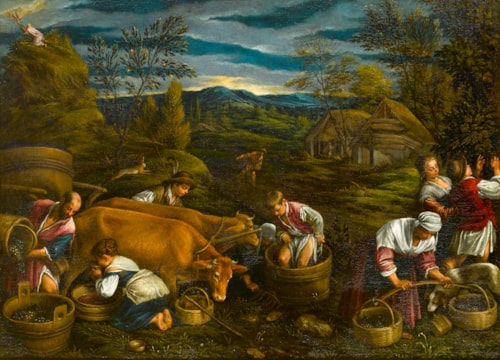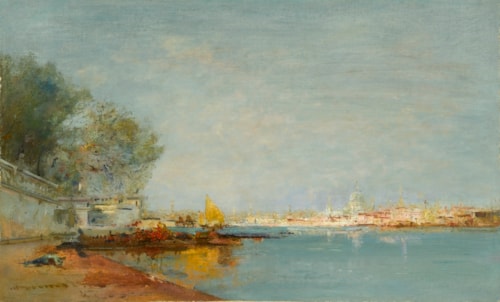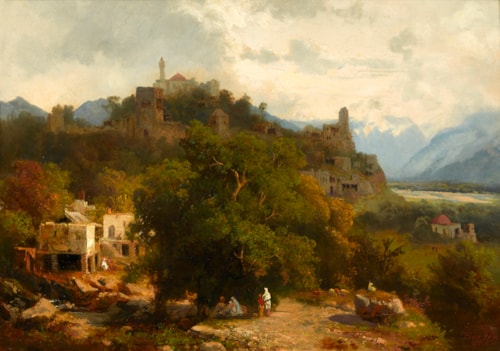acques d' Arthois
(Brussels 1613 - Brussels 1686)
An Extensive Wooded Landscape with Travellers on a Path
oil on canvas
74.8 x 96.2 cm (29½ x 37⅞ in)
The tall, elongated trees filled with rich foliage frame the composition vertically, and the varying shades of green, red and pink tingeing the leaves suggest that An Extensive Wooded Landscape with Travellers on a Path represents an autumnal scene. In the centre, a narrow path leads the viewer’s eye to a group of travellers resting. Two figures stand, one holding a long staff, whilst three others sit on the grassy verge. To the right of the group further along the pathway, another figure, a solitary walker holding two sticks, can just be made out, a dog perhaps leading the way. In the far distance there is a shimmering river lined with trees and beyond, the pointed steeple of a village church rises from the hazy, blue-toned settlement.
Though the geographical location of the present work is unknown, it may possibly depict the Soignies area of Hainaut (now Belgium) where Jacques d’Arthois had a home, and the village seen in the distance is perhaps Casteau. Casteau sits in the valley of the River Obrecheuil, which could be the body of water seen in the present work. D’Arthois drew much of his inspiration from the Forêt de Soignies, and he specialised in depicting the varied views from the edges of the forest, rather than the bosky forest interior. He and several other artists, including Lodewijk de Vadder and Lucas Achtschellinck, who also lived and worked in the forest, later became known as the Soignies forest painters.
D’Arthois’s oeuvre is distinctive for its lush, tactile vegetation, ponds, clay banks, pathways and tall trees crowned with a billowing canopy of leaves and branches. All these elements are present in d’Arthois’s An Extensive Wooded Landscape with Travellers on a Path and also his Landscape with a Herd in the Hermitage with which the present work bears great similarities. The confident brushwork focuses on the vegetation, and the boldness with which he applies paint suggests some influence of Rubens. As in Landscape with a Herd the palette in the present work adheres to the traditional Flemish framework of the brown, green, blue scheme as the landscape recedes from the foreground to the background. Three of d’Arthois’s other landscape paintings bear the monogram of David Teniers II, who painted the figures, and eight were engraved by Wenceslas Hollar.
D'Arthois was a Flemish painter, draughtsman and collector, and was one of the leading figures of the Brussels landscape school of the second half on the seventeenth century. He was apprenticed to Jan Mertens in 1625 and became a master in the Brussels painters’ guild in 1634. In 1636 he married Marie Sampels, with whom he had eight children. Besides his son Jan Baptist d’Arthois, and his brother Nicolaes d’Arthois, Jacques is known to have had at least six pupils. In 1655 he was made chartered tapestry cartoon designer of the city of Brussels, and when he died in 1686 he owned several houses and a substantial painting collection, though his lavish lifestyle had left him severely in debt.
The tall, elongated trees filled with rich foliage frame the composition vertically, and the varying shades of green, red and pink tingeing the leaves suggest that An Extensive Wooded Landscape with Travellers on a Path represents an autumnal scene. In the centre, a narrow path leads the viewer’s eye to a group of travellers resting. Two figures stand, one holding a long staff, whilst three others sit on the grassy verge. To the right of the group further along the pathway, another figure, a solitary walker holding two sticks, can just be made out, a dog perhaps leading the way. In the far distance there is a shimmering river lined with trees and beyond, the pointed steeple of a village church rises from the hazy, blue-toned settlement.
Though the geographical location of the present work is unknown, it may possibly depict the Soignies area of Hainaut (now Belgium) where Jacques d’Arthois had a home, and the village seen in the distance is perhaps Casteau. Casteau sits in the valley of the River Obrecheuil, which could be the body of water seen in the present work. D’Arthois drew much of his inspiration from the Forêt de Soignies, and he specialised in depicting the varied views from the edges of the forest, rather than the bosky forest interior. He and several other artists, including Lodewijk de Vadder and Lucas Achtschellinck, who also lived and worked in the forest, later became known as the Soignies forest painters.
D’Arthois’s oeuvre is distinctive for its lush, tactile vegetation, ponds, clay banks, pathways and tall trees crowned with a billowing canopy of leaves and branches. All these elements are present in d’Arthois’s An Extensive Wooded Landscape with Travellers on a Path and also his Landscape with a Herd in the Hermitage with which the present work bears great similarities. The confident brushwork focuses on the vegetation, and the boldness with which he applies paint suggests some influence of Rubens. As in Landscape with a Herd the palette in the present work adheres to the traditional Flemish framework of the brown, green, blue scheme as the landscape recedes from the foreground to the background. Three of d’Arthois’s other landscape paintings bear the monogram of David Teniers II, who painted the figures, and eight were engraved by Wenceslas Hollar.
D'Arthois was a Flemish painter, draughtsman and collector, and was one of the leading figures of the Brussels landscape school of the second half on the seventeenth century. He was apprenticed to Jan Mertens in 1625 and became a master in the Brussels painters’ guild in 1634. In 1636 he married Marie Sampels, with whom he had eight children. Besides his son Jan Baptist d’Arthois, and his brother Nicolaes d’Arthois, Jacques is known to have had at least six pupils. In 1655 he was made chartered tapestry cartoon designer of the city of Brussels, and when he died in 1686 he owned several houses and a substantial painting collection, though his lavish lifestyle had left him severely in debt.





 contact
contact contact
contact +44 20 7313 8040
+44 20 7313 8040









